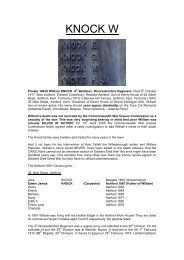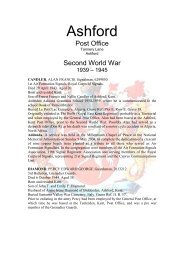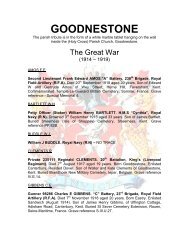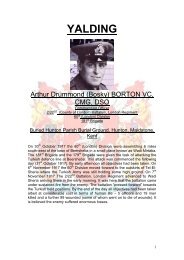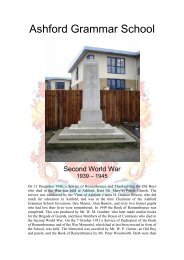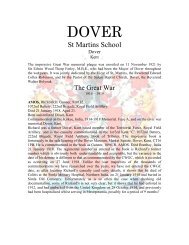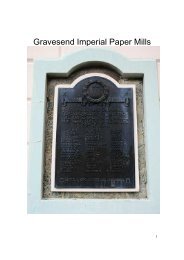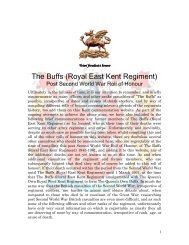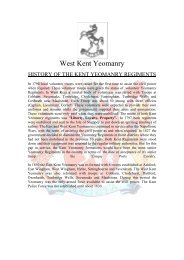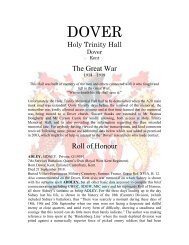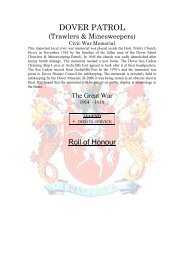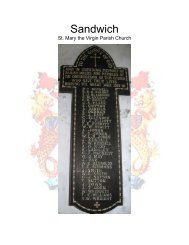You also want an ePaper? Increase the reach of your titles
YUMPU automatically turns print PDFs into web optimized ePapers that Google loves.
LEDGER, FREDERICK JAMES. Boy 1st Class, J/31829.<br />
Royal Navy, H.M.S. Indefatigable.<br />
Died Wednesday 31 May 1916. Aged 17.<br />
Born Crawley, Sussex 11 April 1899.<br />
Eldest son of Annie Ledger and the late Frederick Ledger of St. Michaels,<br />
Tenterden, <strong>Kent</strong>.<br />
Commemorated on the Chatham Naval Memorial. Panel 16, as shown above.<br />
At the time of the 1901 census, the Ledger family resided at Little Hill, Ashford<br />
Road, St. Michaels, Tenterden, <strong>Kent</strong>. Head of the house was 38 year old<br />
Biddenden, Ashford, <strong>Kent</strong> native Frederick Ledger (senior), who was employed<br />
as a Labourer. The death of 46 year old Frederick Ledger (senior), was<br />
Registered in the Tenterden, <strong>Kent</strong>, Registration District during the third quarter of<br />
1909, which left Annie Ledger with six children to bring up on her own. Frederick<br />
was killed during the ‘Battle of Jutland,’ 31 May 1916 - 1 June 1916 which was<br />
the largest naval battle of the Great War. H.M.S. Indefatigable, on which<br />
Frederick was serving when he was killed, was a 22,485 ton Royal Navy<br />
Indefatigable class battlecruiser. Built at Devonport Dockyard, H.M.S.<br />
Indefatigable was laid down in 1909, and commissioned two years later. It is<br />
thought that she was hit by a shell in her X turret which ignited cordite charges,<br />
the resultant flash shooting down to the aft magazines. It is equally plausible that<br />
a shell may have penetrated her magazine directly. The Indefatigable class was<br />
an enlarged version of the earlier Invincible class of Royal Navy battlecruisers. At<br />
the commencement of the Great War, H.M.S. Indefatigable was serving with the<br />
2nd Battlecruiser Squadron in the Mediterranean, where she unsuccessfully<br />
pursued the 22,640 ton Moltke class German battlecruiser Goeben and the 4,915<br />
ton Magdeburg class light cruiser Breslau, as they both fled towards the Ottoman<br />
Empire, at which time these two ships, commanded by Rear Admiral Wilhelm<br />
Souchon, constituted the entire German Mediterranean Division. H.M.S.<br />
Indefatigable bombarded the Turkish fortifications defending the Dardanelles on<br />
Tuesday 3 November 1914. On Sunday 24 January 1915 she left for a refit at<br />
Malta, and on Sunday 14 February 1915 H.M.S. Indefatigable left Malta for home<br />
waters. She then rejoined the 2nd Battlecruiser Squadron of the Grand Fleet on<br />
Saturday 20 February 1915. 33 year old Commander Henry Ernest Digby Hugh<br />
Willoughby, Able Bodied Seaman Elliott, Leading Signalman Falmer, and<br />
Signalman Bowyer survived the sinking, and were rescued from the sea by the<br />
German torpedo-boat S16. Regretably Commander Willoughby died of wounds<br />
and exposure later the same day. The following article appertaining to the loss of<br />
Frederick’s ship was published in the <strong>Kent</strong>ish Express on Saturday 17 June<br />
1916:- “The ship was at the rear of the battle cruiser line and was engaged in a<br />
private duel with her opposite number in the German line, the German ship Von<br />
Der Tann. At 1602 hours two shells fell on her upper deck causing X magazine to<br />
explode. She hauled out of line sinking by the stern. She was then hit again on<br />
the forecastle and there followed a much larger explosion in the ship which totally<br />
destroyed her. Two survivors were rescued by a German Destroyer.”<br />
8




